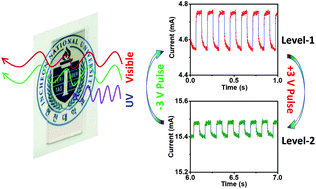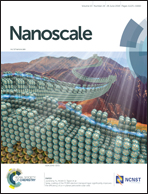A non-volatile “programmable” transparent multilevel ultra-violet perovskite photodetector†
Abstract
Due to their outstanding physical properties, perovskite materials are considered to be promising semiconductors for next-generation optoelectronics. However, these materials are often unstable under an ambient atmosphere and ultra-violet illumination. Therefore, the construction of an air-stable visible light transparent perovskite-based ultra-violet photodetector is still highly challenging. In this study, we go beyond the conventional operation of photodetectors by utilizing the undesired hysteresis loop in the typical current–voltage characteristics of perovskites and design a (C4H9NH3)2PbBr4-based high-performance visible transparent programmable ultra-violet photodetector. The photodetector shows multiple operating levels and can switch from one level to another with a short electric pulse. The photodetector exhibits a fast response time of ∼2 ms, good responsivity of ∼32 mA W−1 and detectivity of 8.5 × 108 Jones with a low working voltage of 0.5 V. Moreover, the photodetector shows long-term stability, and the optoelectronic performance is retained under ambient conditions. This breakthrough in the controlled tunable features opens a new avenue for the development of multipurpose transparent optoelectronic devices.



 Please wait while we load your content...
Please wait while we load your content...